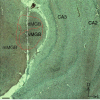Single unit hyperactivity and bursting in the auditory thalamus of awake rats directly correlates with behavioural evidence of tinnitus
- PMID: 25217380
- PMCID: PMC4259543
- DOI: 10.1113/jphysiol.2014.278572
Single unit hyperactivity and bursting in the auditory thalamus of awake rats directly correlates with behavioural evidence of tinnitus
Abstract
Tinnitus is an auditory percept without an environmental acoustic correlate. Contemporary tinnitus models hypothesize tinnitus to be a consequence of maladaptive plasticity-induced disturbance of excitation-inhibition homeostasis, possibly convergent on medial geniculate body (MGB, auditory thalamus) and related neuronal networks. The MGB is an obligate acoustic relay in a unique position to gate auditory signals to higher-order auditory and limbic centres. Tinnitus-related maladaptive plastic changes of MGB-related neuronal networks may affect the gating function of MGB and enhance gain in central auditory and non-auditory neuronal networks, resulting in tinnitus. The present study examined the discharge properties of MGB neurons in the sound-exposure gap inhibition animal model of tinnitus. MGB single unit responses were obtained from awake unexposed controls and sound-exposed adult rats with behavioural evidence of tinnitus. MGB units in animals with tinnitus exhibited enhanced spontaneous firing, altered burst properties and increased rate-level function slope when driven by broadband noise and tones at the unit's characteristic frequency. Elevated patterns of neuronal activity and altered bursting showed a significant positive correlation with animals' tinnitus scores. Altered activity of MGB neurons revealed additional features of auditory system plasticity associated with tinnitus, which may provide a testable assay for future therapeutic and diagnostic development.
© 2014 The Authors. The Journal of Physiology © 2014 The Physiological Society.
Figures






Similar articles
-
Enhanced GABAA-Mediated Tonic Inhibition in Auditory Thalamus of Rats with Behavioral Evidence of Tinnitus.J Neurosci. 2015 Jun 24;35(25):9369-80. doi: 10.1523/JNEUROSCI.5054-14.2015. J Neurosci. 2015. PMID: 26109660 Free PMC article.
-
Auditory thalamic circuits and GABAA receptor function: Putative mechanisms in tinnitus pathology.Hear Res. 2017 Jun;349:197-207. doi: 10.1016/j.heares.2016.08.009. Epub 2016 Aug 21. Hear Res. 2017. PMID: 27553899 Free PMC article. Review.
-
Noise-induced neurophysiological alterations in the rat medial geniculate body and thalamocortical desynchronization by deep brain stimulation.J Neurophysiol. 2021 Feb 1;125(2):661-671. doi: 10.1152/jn.00752.2019. Epub 2021 Jan 6. J Neurophysiol. 2021. PMID: 33405997
-
Changes in auditory thalamus neural firing patterns after acoustic trauma in rats.Hear Res. 2019 Aug;379:89-97. doi: 10.1016/j.heares.2019.05.001. Epub 2019 May 4. Hear Res. 2019. PMID: 31108284
-
Auditory cortex stimulation to suppress tinnitus: mechanisms and strategies.Hear Res. 2013 Jan;295:38-57. doi: 10.1016/j.heares.2012.05.007. Epub 2012 Jun 6. Hear Res. 2013. PMID: 22683861 Review.
Cited by
-
Enhanced GABAA-Mediated Tonic Inhibition in Auditory Thalamus of Rats with Behavioral Evidence of Tinnitus.J Neurosci. 2015 Jun 24;35(25):9369-80. doi: 10.1523/JNEUROSCI.5054-14.2015. J Neurosci. 2015. PMID: 26109660 Free PMC article.
-
Role of auditory-somatosensory corticothalamic circuit integration in analgesia.Cell Calcium. 2023 May;111:102717. doi: 10.1016/j.ceca.2023.102717. Epub 2023 Mar 12. Cell Calcium. 2023. PMID: 36931195 Free PMC article. Review.
-
Current and Emerging Therapies for Chronic Subjective Tinnitus.J Clin Med. 2023 Oct 16;12(20):6555. doi: 10.3390/jcm12206555. J Clin Med. 2023. PMID: 37892692 Free PMC article. Review.
-
Chronic tinnitus and unipolar brush cell alterations in the cerebellum and dorsal cochlear nucleus.Hear Res. 2017 Jul;350:139-151. doi: 10.1016/j.heares.2017.04.016. Epub 2017 May 2. Hear Res. 2017. PMID: 28478300 Free PMC article.
-
Can Animal Models Contribute to Understanding Tinnitus Heterogeneity in Humans?Front Aging Neurosci. 2016 Nov 14;8:265. doi: 10.3389/fnagi.2016.00265. eCollection 2016. Front Aging Neurosci. 2016. PMID: 27895575 Free PMC article. Review.
References
-
- Axelsson A. Ringdahl A. Tinnitus–a study of its prevalence and characteristics. Br J Audiol. 1989;23:53–62. - PubMed
-
- Bajo VM, Rouiller EM, Welker E, Clarke S, Villa AE, de Ribaupierre Y. de Ribaupierre F. Morphology and spatial distribution of corticothalamic terminals originating from the cat auditory cortex. Hear Res. 1995;83:161–174. - PubMed
-
- Bartlett EL. Smith PH. Anatomic, intrinsic, and synaptic properties of dorsal and ventral division neurons in rat medial geniculate body. J Neurophysiol. 1999;81:1999–2016. - PubMed
-
- Bartlett EL. Wang X. Neural representations of temporally modulated signals in the auditory thalamus of awake primates. J Neurophysiol. 2007;97:1005–1017. - PubMed
Publication types
MeSH terms
Grants and funding
LinkOut - more resources
Full Text Sources
Other Literature Sources
Medical
Miscellaneous

